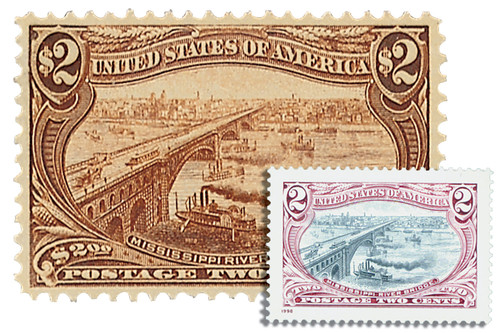U.S. #293
1898 $2 Trans-Mississippi Exposition
First Day of Issue: June 17, 1898
Quantity issued: 56,200 (unknown quantity later destroyed)
Printed by: Bureau of Engraving and Printing
Method: Flat Plate
Watermark: Double-line watermark USPS
Perforation: 12
Color: Orange brown
The two dollar Trans-Mississippi Exposition commemorative stamp pictures the Eads Bridge spanning the Mississippi River in St. Louis, Missouri. In the 19th century, this engineering marvel formed a natural boundary between East and West. At the time of its construction, it was the longest arch bridge in the world, with an overall length of 6,442 feet.
Original plans called for the Eads Bridge to be pictured on the 2¢ Trans-Mississippi stamp. A farming scene was intended for the $2 denomination. A switch was made before the stamps were produced so the farming scene would appear on the 2¢ stamp, the most commonly used in the series.
The $2 Trans-Mississippi stamp was designed by Raymond Ostrander Smith, the Bureau of Engraving and Printing’s chief staff designer. The stamp features the same border as the rest of the values. The vignette (center design) was taken from an admission ticket to the 1896 Republican National Convention that was held in St. Louis.
Unlike the 1893 Columbian series, the Trans-Mississippi Exposition commemoratives didn’t include the name or dates of the event. Instead, each stamp features a caption with the name of the photograph or painting upon which its design is based.
Printed by the Bureau of Engraving and Printing
The Trans-Mississippi commemorative stamps were printed by the Bureau of Engraving and Printing. Original plans called for the series to be printed in bi-color. A brown frame with a black vignette was planned for the $2 Mississippi River Bridge stamp. However, the Spanish-American War strained the resources of the Bureau of Engraving and Printing, which was overburdened by the demand for revenue stamps to fund the war. The Trans-Mississippi commemoratives were printed in a single color, with the $2 denomination printed with orange brown.
The entire printing run of U.S. #293 was done in just one day. Only 56,200 were printed and the commemorative series was sold for a very limited time. An unknown quantity of unsold $2 Trans-Mississippi stamps was destroyed. Experts estimate that 25,000 $2 stamps actually made their way into the public’s hands. A significant number are poorly centered, making finely centered #293 stamps extremely rare.
About the 1898 Trans-Mississippi Exposition Series
The 1898 Trans-Mississippi and International Exposition was held to further the progress and development of natural resources west of the Mississippi River. Held in Omaha, Nebraska, the exposition opened on June 1, 1898, and ran for four months. More than 4,000 exhibits showcased social, economic, and industrial resources of the American West. The expo wasn’t a financial success overall, but it did revitalize Omaha, a community that had been devastated by drought and depression.
Over 2.6 million people attended the expo, which featured the Indian Congress, the largest Native American gathering of its kind. Over 500 members representing 28 tribes camped on the fairgrounds and introduced Americans from the East to their way of life. Reenactments of the explosion of the battleship Maine also fueled patriotism and support for the Spanish-American War.
Because the exposition was held in Omaha, the Trans-Mississippi Exposition commemorative stamps are often called the “Omaha Issue” or simply “Omahas.”
Ranked #8 in 100 Greatest American Stamps
The Trans-Mississippi Exposition series had its critics. In 1902, respected philatelic writer and editor of the Scott Catalogue John Luff was less than flattering. “The stamps are poorly conceived and executed, overloaded with ornaments, heavy in color and blurred in painting.”
Luff represented the minority opinion. In 1933, author Ralph Kimble described the Trans-Mississippi stamps as “perhaps the most attractive set of commemoratives which we have ever had.” Over 70 years later, U.S. #293 was voted #8 in 100 Greatest American Stamps.







